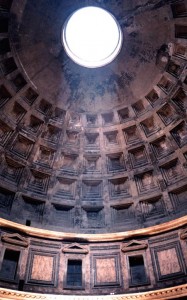This week’s New Scientist magazine features research from University of Otago researcher Robert Hannah suggests Rome’s beloved Pantheon, originally built as a temple to the Roman Gods, was also used as a massive sundial.
 As New Scientist reports, it was while on a book research trip to Rome that Hannah realised the Pantheon may be more than just a temple:
As New Scientist reports, it was while on a book research trip to Rome that Hannah realised the Pantheon may be more than just a temple:
“During the six months of winter, the light of the noon sun traces a path across the inside of the domed roof. During summer, with the sun higher in the sky, the shaft shines onto the lower walls and floor. At the two equinoxes in March and September, the sunlight coming in through the hole strikes the junction between the roof and wall, above the Pantheon’s grand northern doorway.
A grille above the door allows a sliver of light through to the front courtyard – the only moment in the year that it sees sunlight if its main doors are closed. Hannah reckons this is no coincidence… (read on)
Robert Hannah’s book Time in Antiquity is also reviewed in New Scientist.
News wrap: